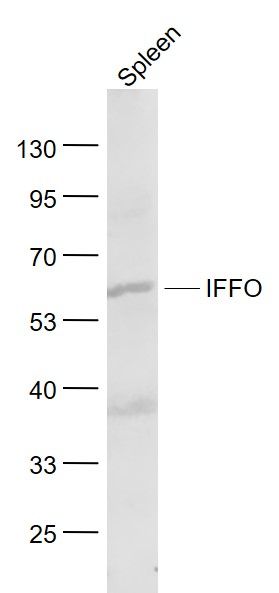IFFO Polyclonal Antibody
Purified Rabbit Polyclonal Antibody (Pab)
- SPECIFICATION
- CITATIONS
- PROTOCOLS
- BACKGROUND

Application
| WB, IHC-P, IHC-F, IF, ICC, E |
|---|---|
| Primary Accession | Q0D2I5 |
| Reactivity | Rat, Dog, Bovine |
| Host | Rabbit |
| Clonality | Polyclonal |
| Calculated MW | 62 KDa |
| Physical State | Liquid |
| Immunogen | KLH conjugated synthetic peptide derived from human IFFO |
| Epitope Specificity | 401-500/559 |
| Isotype | IgG |
| Purity | affinity purified by Protein A |
| Buffer | 0.01M TBS (pH7.4) with 1% BSA, 0.02% Proclin300 and 50% Glycerol. |
| SIMILARITY | Belongs to the intermediate filament family. |
| Important Note | This product as supplied is intended for research use only, not for use in human, therapeutic or diagnostic applications. |
| Background Descriptions | Intermediate filaments are composed of two-chain, a-helical, coiled-coil molecules arranged on an imperfect helical lattice. They have been widely used as markers for distinguishing individual cell types within a tissue and identifying the origins of metastatic tumors. Vimentin is a general marker of cells originating in the mesenchyme and is frequently co-expressed with other members of the intermediate filament family, such as the cytokeratins, in certain neoplasms. Vimentin and Desmin, a related class III intermediate filament, are both expressed during skeletal muscle development. Desmuslin links Desmin to the extracellular matrix and provides structural support in muscle. HOM-TES-103, also known as intermediate filament family orphan 1 (IFFO1), is a 559 amino acid protein that belongs to the intermediate filament family. Ubiquitously expressed, HOM-TES-103 exists as seven alternatively spliced isoforms. |
| Gene ID | 25900 |
|---|---|
| Other Names | Non-homologous end joining factor IFFO1, NHEJ factor IFFO1, Intermediate filament family orphan 1, Tumor antigen HOM-TES-103, IFFO1 (HGNC:24970), IFFO |
| Target/Specificity | Ubiquitously expressed. |
| Dilution | WB=1:500-2000,IHC-P=1:100-500,IHC-F=1:100-500,ICC=1:100-500,IF=1:100-500,ELISA=1:5000-10000 |
| Format | 0.01M TBS(pH7.4), 0.09% (W/V) sodium azide and 50% Glyce |
| Storage | Store at -20 ℃ for one year. Avoid repeated freeze/thaw cycles. When reconstituted in sterile pH 7.4 0.01M PBS or diluent of antibody the antibody is stable for at least two weeks at 2-4 ℃. |
| Name | IFFO1 (HGNC:24970) |
|---|---|
| Synonyms | IFFO |
| Function | Nuclear matrix protein involved in the immobilization of broken DNA ends and the suppression of chromosome translocation during DNA double-strand breaks (DSBs) (PubMed:31548606). Interacts with the nuclear lamina component LMNA, resulting in the formation of a nucleoskeleton that relocalizes to the DSB sites in a XRCC4-dependent manner and promotes the immobilization of the broken ends, thereby preventing chromosome translocation (PubMed:31548606). Acts as a scaffold that allows the DNA repair protein XRCC4 and LMNA to assemble into a complex at the DSB sites (PubMed:31548606). |
| Cellular Location | Nucleus. Nucleus, nucleoplasm. Nucleus inner membrane. Nucleus matrix. Note=Mainly soluble, the remaining is localized in the nuclear matrix (PubMed:31548606). Localized at double- strand break (DSB) sites near the lamina and nuclear matrix structures (PubMed:31548606). |
| Tissue Location | Ubiquitously expressed. |

Thousands of laboratories across the world have published research that depended on the performance of antibodies from Abcepta to advance their research. Check out links to articles that cite our products in major peer-reviewed journals, organized by research category.
info@abcepta.com, and receive a free "I Love Antibodies" mug.
Provided below are standard protocols that you may find useful for product applications.
If you have used an Abcepta product and would like to share how it has performed, please click on the "Submit Review" button and provide the requested information. Our staff will examine and post your review and contact you if needed.
If you have any additional inquiries please email technical services at tech@abcepta.com.













 Foundational characteristics of cancer include proliferation, angiogenesis, migration, evasion of apoptosis, and cellular immortality. Find key markers for these cellular processes and antibodies to detect them.
Foundational characteristics of cancer include proliferation, angiogenesis, migration, evasion of apoptosis, and cellular immortality. Find key markers for these cellular processes and antibodies to detect them. The SUMOplot™ Analysis Program predicts and scores sumoylation sites in your protein. SUMOylation is a post-translational modification involved in various cellular processes, such as nuclear-cytosolic transport, transcriptional regulation, apoptosis, protein stability, response to stress, and progression through the cell cycle.
The SUMOplot™ Analysis Program predicts and scores sumoylation sites in your protein. SUMOylation is a post-translational modification involved in various cellular processes, such as nuclear-cytosolic transport, transcriptional regulation, apoptosis, protein stability, response to stress, and progression through the cell cycle. The Autophagy Receptor Motif Plotter predicts and scores autophagy receptor binding sites in your protein. Identifying proteins connected to this pathway is critical to understanding the role of autophagy in physiological as well as pathological processes such as development, differentiation, neurodegenerative diseases, stress, infection, and cancer.
The Autophagy Receptor Motif Plotter predicts and scores autophagy receptor binding sites in your protein. Identifying proteins connected to this pathway is critical to understanding the role of autophagy in physiological as well as pathological processes such as development, differentiation, neurodegenerative diseases, stress, infection, and cancer.


